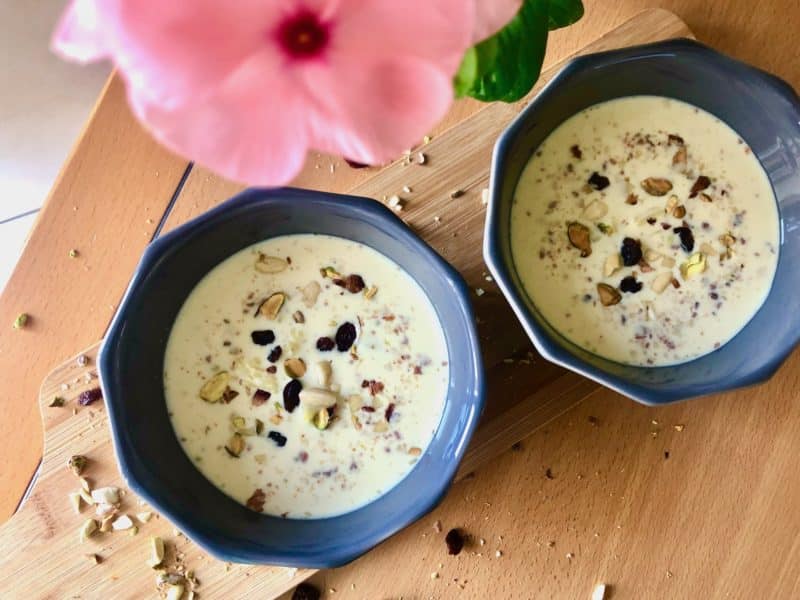Kheer; a creamy Indian-style rice pudding kissed with flavours of saffron and cardamom, and laced with chopped nuts and dried fruits.
India. One of the largest and most populous countries in the world. With over 1 billion inhabitants that speak many languages and practice many religions, to call India diverse would be an understatement.
As part of a new series here on the blog and on my YouTube channel, I want to try and recreate desserts from all over the planet (desserts of the world, if you will). Every week or so I want to get stuck into a new sweet treat from a far flung place, or a place just down the road.
Today is the first instalment of this new series, and it took me a while to decide where I wanted to take inspiration from first. Rather than sitting in my European comfort zone, I decided to tackle flavours and cooking methods from somewhere on the other side of the world. India.
Some of my lovely Instagram followers and YouTube subscribers currently live in, or hail from, India and provided me with a wealth of suggestions as to what are India’s most iconic desserts and sweets.
With a country as big as India it can be difficult to pinpoint a dish that represents people and their culture across the nation, not just in one specific region. However, thanks to some kind people, the internet in general, and some incredibly helpful Indian food blogs, I hope I have done that today.
Today I’m sharing a recipe for kheer.
If you prefer a recipe video – you can watch it here!

Kheer, also known by other names such as kheeri or payasam in some regions of India, is a sweet dish that appears to be popular all over the country. From what I have gathered, the basic ingredients are typically milk, sugar, and some kind of grain (most commonly being rice).
I imagine the reason it is so commonly made all across India is because the basic ingredients are both affordable and accessible to most. According to some food blogs I’ve read, it can be made for celebrations such as Diwali but also as a common dessert. It may not be the most glamorous or intricate of special occasion desserts on the world stage, but appears to be one rooted in the country’s collective history. Oh, and it looks, smells, and tastes absolutely delicious.
The choice of spices and flavourings typically appear to be cardamom, rose water, and/or saffron. However, due to differences in culture, geography, and palate, some regions in the south of India also apparently add ghee and jaggery for flavour too.

Kheer is both comforting and satisfying while also being light and delicate. Subtle flavours of rich saffron and fragrant cardamom blend beautifully with the creamy pudding. It’s far from the British-style rice pudding that I ate as a kid, but definitely one I’d recommend.
Cool refreshing milky pudding, soft rice, crunchy chopped nuts, sweet and chewy dried fruit. As with so many other Indian dishes I’ve had the absolute pleasure of tasting, this is a dish with layers of tastes and textures.
I’ve read that it’s a dish that can be served warm or cold. Having personally only dared to try it chilled in Italy’s current 40 degree temperatures, I can imagine it’s equally delicious in the depths of a cold winter.
I’d like to say a big thanks to Dassana’s veg recipes, Cook with Manali, Indian healthy recipes, and Tarla Dalal for the information and inspiration behind today’s post and in this version of an Indian classic.
But let’s get into this first instalment of trying desserts of the world and make some Indian Kheer!
Want to save this Kheer recipe for later? You can pin the image below!
To make this Kheer, simply follow the recipe below:
Ingredients
- 1 (4 cups) litre whole milk, or a rich plant-based milk to make vegan
- 50g (¼ cup) white basmati rice
- 50g (¼ cup) sugar
- 4 green cardamom pods
- 6-12 strands saffron
- 1 tbsp chopped almonds, plus extra to decorate
- 1 tbsp chopped pistachios, plus extra to decorate
- 1 tbsp raisins, plus extra to decorate
Instructions
- Wash your rice thoroughly. Then pour it into a bowl and soak it in clean water for 20-30 mins.
- Place a large saucepan or pot over a low-medium heat and pour in your milk. Heat it, stirring occasionally, until hot to the touch.
- Once hot, remove one ladle of the milk and pour it into a mug or small bowl with your saffron strands to steep gently. Set aside.
- Drain the water from the soaked rice and pour the rice into the pot of remaining hot milk.
- Cook rice gently in the milk over a low heat in the remaining milk for 15 mins, stirring occasionally to ensure it doesn’t stick to the base of the pot.
- Meanwhile, using a mortar and pestle or spice grinder, shell and grind your cardamom seeds into a fine dusty shrapnel.
- Stir the ground cardamom into the sugar in a mug or small bowl before stirring into your pot and cooking for a further 15 minutes. Stir occasionally as before.
- Add the saffron-infused milk (including the strands), nuts, and raisins to the pot and allow it to cook gently for a further 2-5 minutes.
- Remove the pot from the heat. You can serve the kheer warm, or allow it to cool completely and chill in the fridge.
- Serve generously in bowls topped with more nuts and raisins.
- Enjoy!
BE A MAVERICK: why not try this recipe with coconut milk, almond milk, or another creamy plant-based milk to make it vegan?
This Kheer will keep well in the fridge for up to 2 days, but is best enjoyed fresh!
You may also like:





